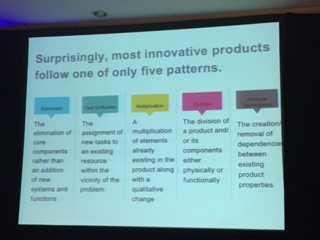Innovation
Inside the Box: A Systematic Approach to Link Innovation and Marketing Strategy
Inside the Box: A Systematic Approach to Link Innovation and Marketing Strategy
By Drew Boyd, Executive Director of the Master of
Science in Marketing, University of Cincinnati
Science in Marketing, University of Cincinnati
Back
End of Innovation Conference Keynote: 2016
The thesis of this talk is that Creativity is a skill, not a
gift. This practical advice starts with a promise from Boyd: 'I'm going to
teach you how to use your brain to innovate anyway you want.'
gift. This practical advice starts with a promise from Boyd: 'I'm going to
teach you how to use your brain to innovate anyway you want.'
He then discussed the origin story of the 'think
outside of the box' mythology. When you send people outside of the box, the
mind suffers anxiety. The mind works better inside the box, he says, with
constraints.
outside of the box' mythology. When you send people outside of the box, the
mind suffers anxiety. The mind works better inside the box, he says, with
constraints.
He then quoted Beatle Paul about 'templates' for
songwriting. All artist use patterns, he claims. But the artists don't want you
to see the patterns. Patterns boost the creative output. 'Innovators and
inventors use patterns, too, and they are embedded in the products and services
you see everyday.'
songwriting. All artist use patterns, he claims. But the artists don't want you
to see the patterns. Patterns boost the creative output. 'Innovators and
inventors use patterns, too, and they are embedded in the products and services
you see everyday.'
The method is Systematic Inventive Thinking'and
there are only five patterns. 'Innovation follow as set of patterns:
Subtractions, task unification, multiplication, division, attribute
dependency.'
there are only five patterns. 'Innovation follow as set of patterns:
Subtractions, task unification, multiplication, division, attribute
dependency.'
Using these patterns you can move from solution
to problem, rather than problem to solution.
to problem, rather than problem to solution.
To use this method, start with an existing
situation, and then apply one of the five patterns from above. This thinking
tool will yield a virtual product, then vets if it is desired and feasible. At
this stage, an idea is born.
situation, and then apply one of the five patterns from above. This thinking
tool will yield a virtual product, then vets if it is desired and feasible. At
this stage, an idea is born.
Let's we examine the Subtraction technique. Here's
the method: remove a component, then visualize the new prototype, identify user
needs, and then adapt as needed based on the factors of 'the closed world.'
Taking each piece out and thinking about the possibilities opens up new paths
of innovation.
the method: remove a component, then visualize the new prototype, identify user
needs, and then adapt as needed based on the factors of 'the closed world.'
Taking each piece out and thinking about the possibilities opens up new paths
of innovation.
This method forces you to create combinations
that you wouldn't create on your own.
that you wouldn't create on your own.
Task Unification is the next method we explored.
Here you assign an additional task to a component and walk through the
remaining steps of can we and should we do it.
Here you assign an additional task to a component and walk through the
remaining steps of can we and should we do it.
We used 'How we can keep consumers in grocery
stores longer'? as an exercise. We listed all components, chose one, and then
create ideas quickly, with time constraints.
stores longer'? as an exercise. We listed all components, chose one, and then
create ideas quickly, with time constraints.
The exercise demonstrated the effectiveness of
the technique. Many new ideas were generated. The constraints forced new
thinking, new potential value.
the technique. Many new ideas were generated. The constraints forced new
thinking, new potential value.
Boyd then gave many examples of the five
techniques. The book explaining these methods is called Inside the Box.
techniques. The book explaining these methods is called Inside the Box.
Many of the innovators were excited about this
technique, which works backwards from the empathy-first methods so popular
today. Boyd claims that these methods improve the efficacy of brainstorming
exponentially.
technique, which works backwards from the empathy-first methods so popular
today. Boyd claims that these methods improve the efficacy of brainstorming
exponentially.
Michael Graber is the
managing partner of the Southern Growth Studio, an innovation and strategic
growth firm based in Memphis, TN and the author of Going Electric, and also serves as VP Innovation at Hunter Fan. Visit www.southerngrowthstudio.com to learn more.
managing partner of the Southern Growth Studio, an innovation and strategic
growth firm based in Memphis, TN and the author of Going Electric, and also serves as VP Innovation at Hunter Fan. Visit www.southerngrowthstudio.com to learn more.

